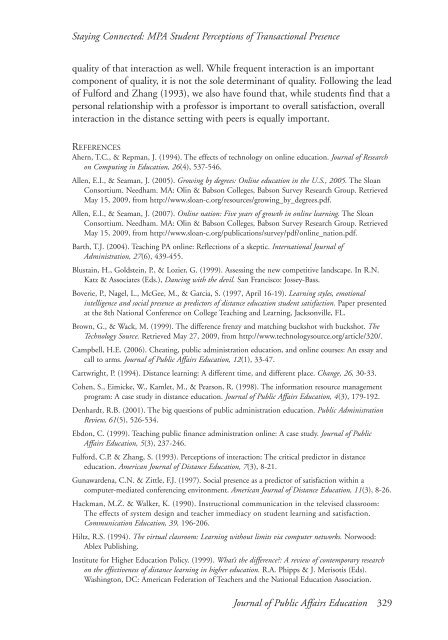journal of public affairs education - NASPAA *The Global Standard ...
journal of public affairs education - NASPAA *The Global Standard ...
journal of public affairs education - NASPAA *The Global Standard ...
- No tags were found...
You also want an ePaper? Increase the reach of your titles
YUMPU automatically turns print PDFs into web optimized ePapers that Google loves.
Staying Connected: MPA Student Perceptions <strong>of</strong> Transactional Presencequality <strong>of</strong> that interaction as well. While frequent interaction is an importantcomponent <strong>of</strong> quality, it is not the sole determinant <strong>of</strong> quality. Following the lead<strong>of</strong> Fulford and Zhang (1993), we also have found that, while students find that apersonal relationship with a pr<strong>of</strong>essor is important to overall satisfaction, overallinteraction in the distance setting with peers is equally important.REFERENCESAhern, T.C., & Repman, J. (1994). The effects <strong>of</strong> technology on online <strong>education</strong>. Journal <strong>of</strong> Researchon Computing in Education, 26(4), 537-546.Allen, E.I., & Seaman, J. (2005). Growing by degrees: Online <strong>education</strong> in the U.S., 2005. The SloanConsortium. Needham. MA: Olin & Babson Colleges, Babson Survey Research Group. RetrievedMay 15, 2009, from http://www.sloan-c.org/resources/growing_by_degrees.pdf.Allen, E.I., & Seaman, J. (2007). Online nation: Five years <strong>of</strong> growth in online learning. The SloanConsortium. Needham. MA: Olin & Babson Colleges, Babson Survey Research Group. RetrievedMay 15, 2009, from http://www.sloan-c.org/<strong>public</strong>ations/survey/pdf/online_nation.pdf.Barth, T.J. (2004). Teaching PA online: Reflections <strong>of</strong> a skeptic. International Journal <strong>of</strong>Administration, 27(6), 439-455.Blustain, H., Goldstein, P., & Lozier, G. (1999). Assessing the new competitive landscape. In R.N.Katz & Associates (Eds.), Dancing with the devil. San Francisco: Jossey-Bass.Boverie, P., Nagel, L., McGee, M., & Garcia, S. (1997, April 16-19). Learning styles, emotionalintelligence and social presence as predictors <strong>of</strong> distance <strong>education</strong> student satisfaction. Paper presentedat the 8th National Conference on College Teaching and Learning, Jacksonville, FL.Brown, G., & Wack, M. (1999). The difference frenzy and matching buckshot with buckshot. TheTechnology Source. Retrieved May 27, 2009, from http://www.technologysource.org/article/320/.Campbell, H.E. (2006). Cheating, <strong>public</strong> administration <strong>education</strong>, and online courses: An essay andcall to arms. Journal <strong>of</strong> Public Affairs Education, 12(1), 33-47.Cartwright, P. (1994). Distance learning: A different time, and different place. Change, 26, 30-33.Cohen, S., Eimicke, W., Kamlet, M., & Pearson, R. (1998). The information resource managementprogram: A case study in distance <strong>education</strong>. Journal <strong>of</strong> Public Affairs Education, 4(3), 179-192.Denhardt, R.B. (2001). The big questions <strong>of</strong> <strong>public</strong> administration <strong>education</strong>. Public AdministrationReview, 61(5), 526-534.Ebdon, C. (1999). Teaching <strong>public</strong> finance administration online: A case study. Journal <strong>of</strong> PublicAffairs Education, 5(3), 237-246.Fulford, C.P. & Zhang, S. (1993). Perceptions <strong>of</strong> interaction: The critical predictor in distance<strong>education</strong>. American Journal <strong>of</strong> Distance Education, 7(3), 8-21.Gunawardena, C.N. & Zittle, F.J. (1997). Social presence as a predictor <strong>of</strong> satisfaction within acomputer-mediated conferencing environment. American Journal <strong>of</strong> Distance Education, 11(3), 8-26.Hackman, M.Z. & Walker, K. (1990). Instructional communication in the televised classroom:The effects <strong>of</strong> system design and teacher immediacy on student learning and satisfaction.Communication Education, 39, 196-206.Hiltz, R.S. (1994). The virtual classroom: Learning without limits via computer networks. Norwood:Ablex Publishing.Institute for Higher Education Policy. (1999). What’s the difference?: A review <strong>of</strong> contemporary researchon the effectiveness <strong>of</strong> distance learning in higher <strong>education</strong>. R.A. Phipps & J. Merisotis (Eds).Washington, DC: American Federation <strong>of</strong> Teachers and the National Education Association.Journal <strong>of</strong> Public Affairs Education 329
















